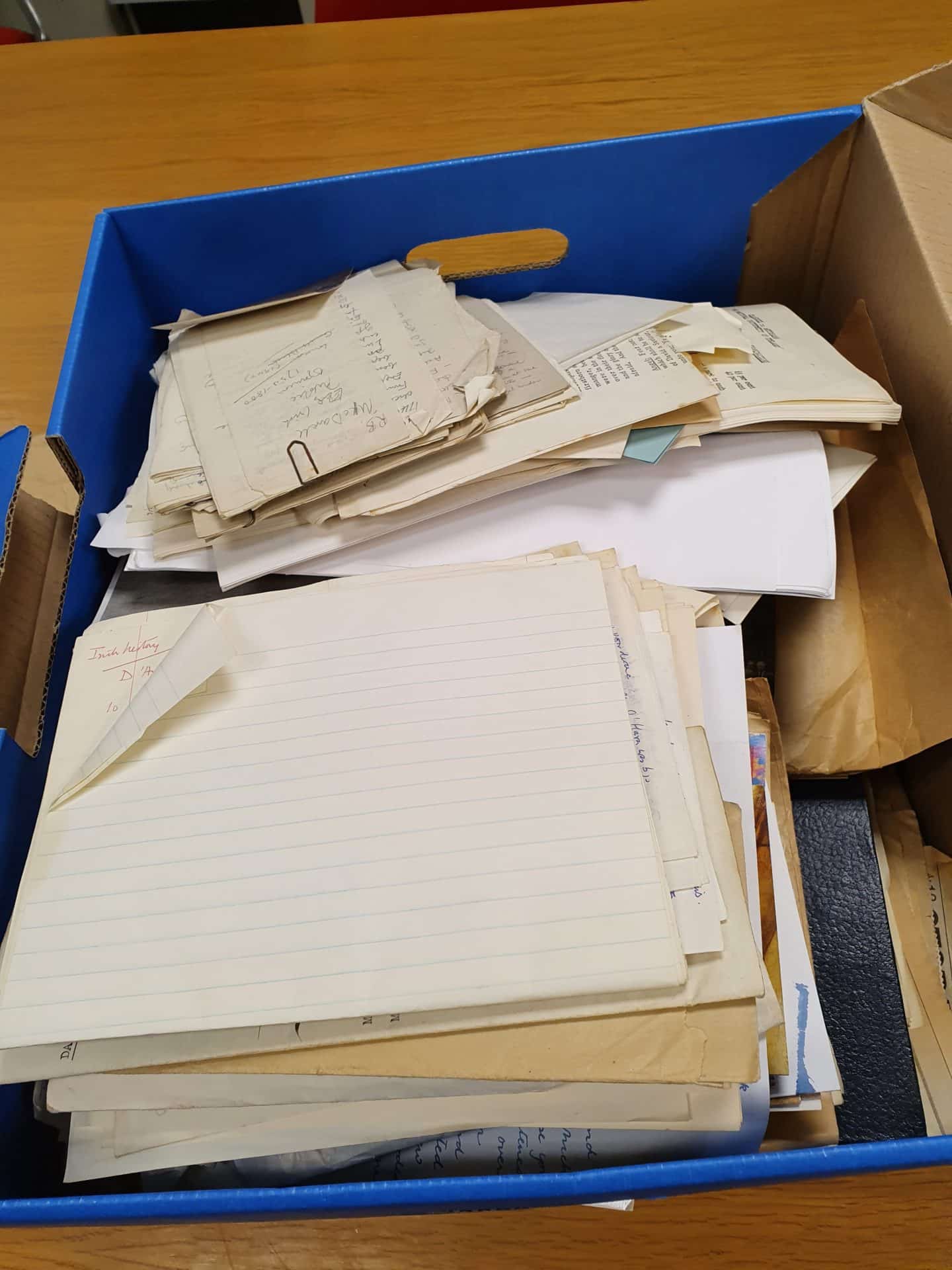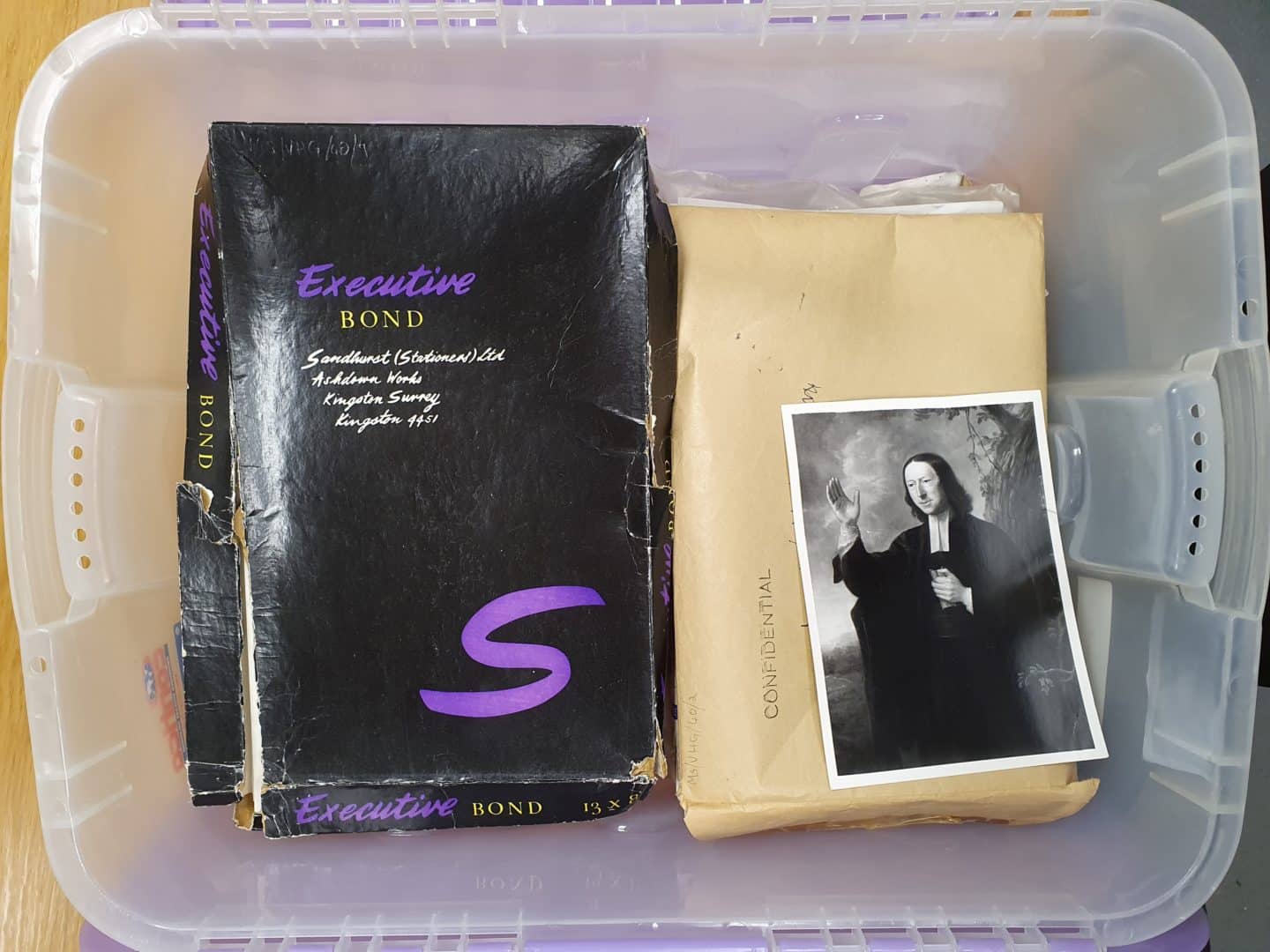Blog Post
Cataloguing literary and scientific papers in the Archive (part 2)
Lockdown
In late March 2020 Lincoln College Archive was forced to rapidly adopt new working practices as a result of the restrictions introduced during the Covid-19 pandemic. I found myself working from home, which forced me to come up with new ways of contributing to the Archive. On 19 March, which was my last day in the Archive office until 28 May, I photographed the remaining literary and scientific papers which I was due to catalogue during my time at Lincoln – some material from the William Warde Fowler collection, the Colin Bell Archive and some scientific papers by Howard Florey – in as much detail as possible so that I could catalogue them from home. I also signed up for remote desktop access and a VPN so I could access my work computer from home.
Although working on the Archive at home took some getting used to as I had previously been used to being able to refer to any item in the strong room at any time, I soon got used to the new routine of working from home, and found several tasks which I could complete remotely, some of which may not otherwise have been done. I finished cataloguing the literary and scientific papers using the photographs I had taken and the notes I had made, and continued the endless task of proofreading the archival descriptions I had created to ensure accuracy and clarity.
Following this, I set about improving the indexing of archival records that had already been catalogued, working with College Archivist Lindsay McCormack and Archive Assistant Alice Parkin. I started by checking all existing name and place indexes that I had created to ensure that they were in a consistent format, and then set about adding name and place indexes for collections that have already been catalogued, including the Papers of Anthony Goodman, The Papers of Denis Hills and the College’s collections relating to John Wesley and Frank Taylor. This involved a lot of often repetitive work, especially for the Papers of Anthony Goodman, which includes thousands of digital articles by Goodman and others, including many duplicates of the same articles, but since Epexio is indexed by Google, has made these collections more accessible and has resulted in an increased number of enquiries relating to the Anthony Goodman material.
I also worked with Lindsay McCormack and Alice Parkin to create a consistent list of subject index terms suited to the Archive’s needs. We began by combining two existing lists of terms, the UK Archival Thesaurus and the UNESCO Thesaurus, and removing terms which were not relevant to us. We then grouped the terms into categories and sent them to Metadatis to be added in bulk to Epexio. In light of the discussions relating to issues of race, privilege and bias following the Black Lives Matter protests in the aftermath of the killing of George Floyd in Minneapolis, we were keen to examine our new subject index to see if there were any problematic terms which needed to be removed, terms which needed to be recategorised or new terms which needed to be added to ensure that the index is inclusive of diverse groups, and we consulted glossaries produced by advocacy groups such as Stonewall’s Glossary of terms in order to find additional terms that could allow our index to represent a wider variety of groups and identities.
Vivian Green
On 28 May I returned to the Archive for the first time in over two months, and from then on would go into the Archive mostly two or three days a week until I moved away from Oxford in September. Returning to the Archive, I found that much had changed, from the fact that I was now on my own to the fact that lunch was not served in College and there were no College events or meetings, to the fact that I had to wash my hands or use sanitiser much more frequently and clean surfaces with wipes at the end of every day. However, in the Archive itself much had remained constant: thanks to control of temperature and relative humidity in the strong room and regular remote and in-person monitoring of conditions in the strong room, the collections themselves survived the experience of lockdown unscathed, and I enjoyed the opportunity to resume a regular routine and to work with physical collections, which is central to working in an archive, and is especially important in my role arranging and cataloguing collections.

Following my return to the Archive I began by checking some items to ensure that my descriptions were correct, and repackaged and reshelved some items which I had catalogued during lockdown after having photographed them. I then turned my attention to the archive of Vivian Green (1915-2005), who was a very important figure at Lincoln in the late twentieth century. This collection, which had been transferred to Lincoln following Green’s death in 2005 and which had otherwise received little attention other than a rudimentary box listing by former archivist Andrew Mussell, was something of a departure from previous collections which I had catalogued during my time at Lincoln in that it came into the archive with very little in the way of an arrangement, not even an earlier arrangement which required modification to better reflect provenance. Although I did not get the opportunity to begin cataloguing this large collection, I listed the contents of each box and gave each item a preliminary reference number, which will allow archivists working on the collection in the future to know what the collection consists of and will facilitate future rearrangement without requiring the archivist to have physical access to the collection.

Since the principle of ‘Original Order’ is central to archival theory and practice, yet the Vivian Green archive did not come into the College Archive with an arrangement reflecting the circumstances of its creation, I turned to the method suggested by archival scholar Jennifer Meehan, who suggests that ‘archivists should analyse and imagine the possible relationships between records and activities. Based on an understanding of these external relationships, archivists then effectively create the internal relationships of a fonds by putting the records in the most appropriate place(s) to reflect the development of the specific activities that gave rise to them and/or the subsequent activities in which they were involved.’ During and following my listing of the items in the collection, I consulted biographical resources to discern the activities in which Green was engaged, and noted where different records seemed to have similar provenances or be the product of specific projects or activities. I grouped items into categories based on the activities that they recorded, and then suggested an outline arrangement for the collection consisting of series and sub-series. My work on the Vivian Green archive should help make this collection more accessible and comprehensible, and serve as a useful starting point for archivists cataloguing it in the future.
Images: Two of many boxes filled up with previously undescribed records of Vivian Green